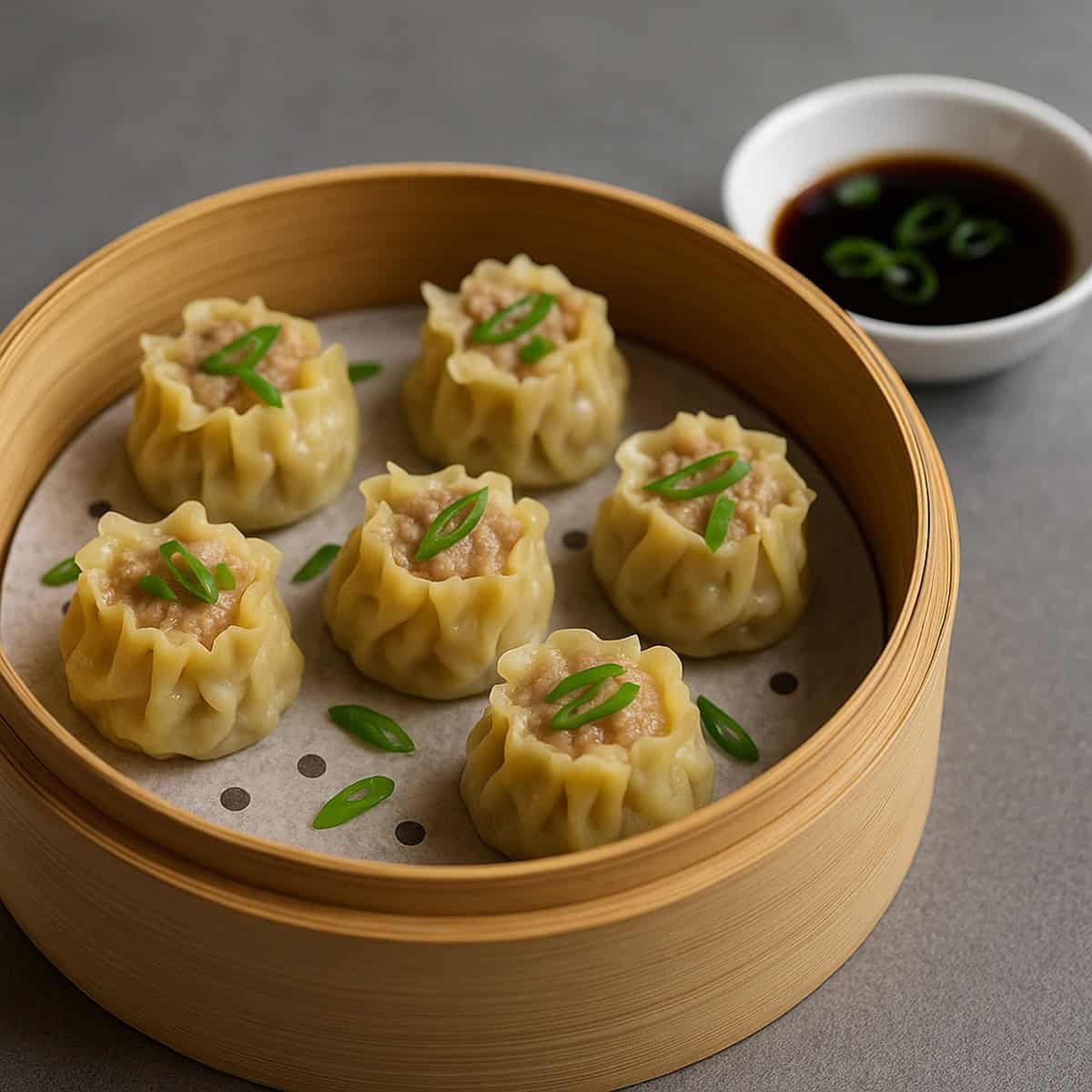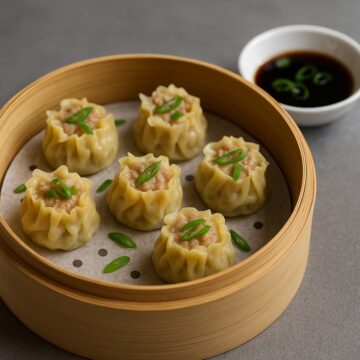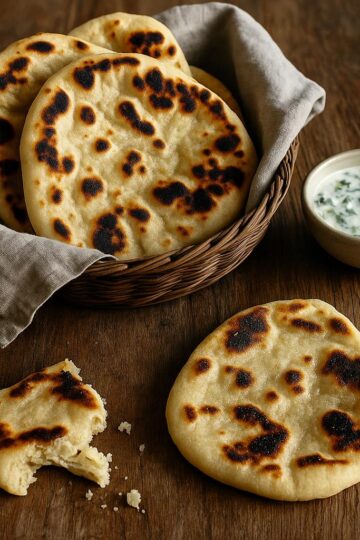
📌 What Is Shu Mai (烧卖 / 燒賣)?
Shu Mai — also spelled Siu Mai, Shumai, or 烧卖 (Mandarin) / 燒賣 (Cantonese) — are iconic Chinese dumplings served in dim sum restaurants across the world. These open-top steamed dumplings are typically filled with a juicy mix of ground pork, shrimp, mushrooms, and ginger, and crowned with a touch of roe or carrot for that signature golden top.
Jump to Recipe
🛒 Ingredients (Makes ~24 dumplings)
Filling:
- ½ lb ground pork (20% fat ideal)
- ¼ lb raw shrimp, peeled, deveined, finely chopped
- 2 dried shiitake mushrooms, rehydrated and minced
- 1 tablespoon soy sauce
- 1 tablespoon oyster sauce
- 1 teaspoon sesame oil
- 1 tablespoon Shaoxing wine
- 1 teaspoon grated ginger
- 1 clove garlic, minced
- 1 teaspoon sugar
- ½ teaspoon white pepper
- 1 tablespoon cornstarch
Wrapper and Topping:
- 24 round dumpling wrappers (or square wonton wrappers with corners trimmed)
- Finely grated carrot or fish roe (for topping)
- Neutral oil for greasing steamer
🔥 Instructions
- Mix the filling: In a large bowl, combine pork, shrimp, mushrooms, seasonings, and cornstarch. Stir vigorously until the mixture becomes sticky and cohesive.
- Assemble the dumplings: Place a wrapper in your palm. Add 1 tablespoon of filling to the center. Gently gather the sides up around the filling, forming an open-topped cylinder. Flatten the bottom to help it stand. Top with a pinch of grated carrot or roe.
- Prep your steamer: Line a bamboo or metal steamer with parchment or cabbage leaves. Lightly oil to prevent sticking.
- Steam the shu mai: Arrange dumplings 1 inch apart. Steam over boiling water for 8–10 minutes, or until pork is fully cooked and filling is firm.
- Serve hot with soy sauce, chili oil, or black vinegar on the side.
🍽️ What to Serve With Shu Mai
- Chinese hot mustard or chili crisp
- Soy sauce + black vinegar dipping sauce
- As part of a dim sum spread with har gow, bao buns, and egg tarts
- Pair with oolong or jasmine tea
💡 Recipe Tips
- Don’t overfill the wrappers — 1 tablespoon is just right.
- Mix the filling thoroughly to develop a springy texture.
- Use shrimp and mushrooms for depth, but feel free to sub in ground chicken or tofu for variations.

Shu Mai (烧卖 / Siu Mai)
Shu Mai — also spelled Siu Mai, Shumai, or 烧卖 (Mandarin) / 燒賣 (Cantonese) — are iconic Chinese dumplings served in dim sum restaurants across the world. These open-top steamed dumplings are typically filled with a juicy mix of ground pork, shrimp, mushrooms, and ginger, and crowned with a touch of roe or carrot for that signature golden top.
Ingredients
Ingredients (Makes ~24 dumplings)
Filling:
- - ½ lb ground pork 20% fat ideal
- - ¼ lb raw shrimp peeled, deveined, finely chopped
- - 2 dried shiitake mushrooms rehydrated and minced
- - 1 tablespoon soy sauce
- - 1 tablespoon oyster sauce
- - 1 teaspoon sesame oil
- - 1 tablespoon Shaoxing wine
- - 1 teaspoon grated ginger
- - 1 clove garlic minced
- - 1 teaspoon sugar
- - ½ teaspoon white pepper
- - 1 tablespoon cornstarch
Wrapper and Topping:
- - 24 round dumpling wrappers or square wonton wrappers with corners trimmed
- - Finely grated carrot or fish roe for topping
- - Neutral oil for greasing steamer
Instructions
- Mix the filling: In a large bowl, combine pork, shrimp, mushrooms, seasonings, and cornstarch. Stir vigorously until the mixture becomes sticky and cohesive.
- Assemble the dumplings: Place a wrapper in your palm. Add 1 tablespoon of filling to the center. Gently gather the sides up around the filling, forming an open-topped cylinder. Flatten the bottom to help it stand. Top with a pinch of grated carrot or roe.
- Prep your steamer: Line a bamboo or metal steamer with parchment or cabbage leaves. Lightly oil to prevent sticking.
- Steam the shu mai: Arrange dumplings 1 inch apart. Steam over boiling water for 8–10 minutes, or until pork is fully cooked and filling is firm.
- Serve hot with soy sauce, chili oil, or black vinegar on the side.
Notes
What to Serve With Shu Mai
- Chinese hot mustard or chili crisp
- Soy sauce + black vinegar dipping sauce
- As part of a dim sum spread with har gow, bao buns, and egg tarts
- Pair with oolong or jasmine tea
Recipe Tips
- Don’t overfill the wrappers — 1 tablespoon is just right.
- Mix the filling thoroughly to develop a springy texture.
- Use shrimp and mushrooms for depth, but feel free to sub in ground chicken or tofu for variations.
Cultural Context
Shu Mai (烧卖) originated from Hohhot, Inner Mongolia, and spread south to Guangdong and Hong Kong, where it became a beloved staple of Cantonese dim sum. Today, siu mai variations can be found throughout Asia — from pork-heavy Chinese versions to glutinous rice-filled shumai in Japan.
- Chinese hot mustard or chili crisp
- Soy sauce + black vinegar dipping sauce
- As part of a dim sum spread with har gow, bao buns, and egg tarts
- Pair with oolong or jasmine tea
Recipe Tips
- Don’t overfill the wrappers — 1 tablespoon is just right.
- Mix the filling thoroughly to develop a springy texture.
- Use shrimp and mushrooms for depth, but feel free to sub in ground chicken or tofu for variations.
Cultural Context
Shu Mai (烧卖) originated from Hohhot, Inner Mongolia, and spread south to Guangdong and Hong Kong, where it became a beloved staple of Cantonese dim sum. Today, siu mai variations can be found throughout Asia — from pork-heavy Chinese versions to glutinous rice-filled shumai in Japan.
Tried this recipe?Let us know how it was!
🌏 Cultural Context
Shu Mai (烧卖) originated from Hohhot, Inner Mongolia, and spread south to Guangdong and Hong Kong, where it became a beloved staple of Cantonese dim sum. Today, siu mai variations can be found throughout Asia — from pork-heavy Chinese versions to glutinous rice-filled shumai in Japan.



Comments
No Comments